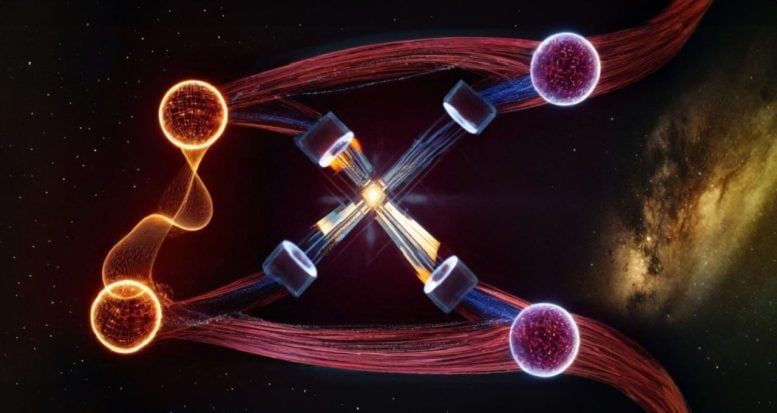Photons at the Edge of Physics Unlock Gravity’s Quantum Secrets


Artistic representation of the implemented photonic experiment in which entanglement between the polarizations of single photons is mediated by the independent degree of freedom of the photon path. Notably, mediated entanglement represents a core principle of future experiments using massive particles, aiming to probe for the first time the quantumness of gravity. Credit: Federico Alfano
Principles behind gravity-mediated entanglement were experimentally demonstrated in a simulation using photons, providing new insights into the nature of gravity.
Researchers are making significant progress in the field of quantum gravity, aiming to reconcile Einstein’s theory of gravity with quantum mechanics. Recent experiments demonstrate the principles of gravity-mediated entanglement using photons, a breakthrough in testing theories like string theory and loop quantum gravity. These experiments could transform our understanding of the universe and support future theoretical frameworks.
Quantum Gravity Research Advances
In a groundbreaking development at the intersection of quantum mechanics and general relativity, researchers have made significant strides toward unraveling the mysteries of quantum gravity. This work sheds new light on future experiments that hold promise for resolving one of the most fundamental enigmas in modern physics: the reconciliation of Einstein’s theory of gravity with the principles of quantum mechanics.
The longstanding challenge of unifying these two pillars of physics has tantalized scientists for decades, spawning various theoretical frameworks such as string theory and loop quantum gravity. However, without experimental verification, these theories remain speculative.
Innovations in Testing Quantum Gravity
How to test the quantum nature of gravity? Tangible means to probe the quantum behavior of the gravitational field were proposed within the last decade (by Marletto and Vedral, and by Bose et al.), based on the concept of “gravity-mediated entanglement.”
In a recent study published in Advanced Photonics Nexus, an international team of researchers achieved a significant goal in preparation for future experiments in the quest to unify quantum mechanics and general relativity. Their work leverages cutting-edge tools and techniques from quantum information theory and quantum optics to demonstrate the principles of gravity-mediated entanglement using particles of light, i.e., photons.
Demonstrating Gravity-Mediated Entanglement
The experiment involves the interaction between photons to mimic the gravitational field’s effect on quantum particles. Remarkably, some properties of the photons, despite never directly interacting, become entangled, showcasing a quintessential quantum phenomenon: nonlocality. This entanglement is mediated by another independent photonic property and mirrors the hypothesized behavior of gravity-mediated entanglement, providing crucial insights into the quantum nature of gravity.
Importantly, the study also addresses the challenge of detecting the entanglement generated in these experiments. By elucidating the constraints and noise sources inherent in such experiments, the researchers pave the way for clarifying concepts and tools to be used for future experiments aimed at directly observing gravity-mediated entanglement.
Implications of Quantum Gravity Experiments
Experimental tests of gravity-mediated entanglement could herald a new era in our understanding of the fundamental nature of the universe. According to author Emanuele Polino, who worked as a postdoc in the Quantum Lab of Sapienza University at the time of the research, supported by the QISS consortium, “The implications of this research are profound. It offers an experimental validation for the principles behind future quantum gravity experiments that will serve as litmus tests for competing theoretical frameworks.”
Continued Exploration in Quantum Gravity
As physicists continue to push the boundaries of experimental and theoretical inquiry, the quest to unlock the secrets of quantum gravity takes a significant step forward with this groundbreaking research.
Reference: “Photonic implementation of quantum gravity simulator” by Emanuele Polino, Beatrice Polacchi, Davide Poderini, Iris Agresti, Gonzalo Carvacho, Fabio Sciarrino, Andrea Di Biagio, Carlo Rovelli and Marios Christodoulou, 22 May 2024, Advanced Photonics Nexus.
DOI: 10.1117/1.APN.3.3.036011


